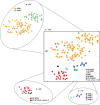Optimizing biomarkers for accurate ependymoma diagnosis, prognostication, and stratification within International Clinical Trials: A BIOMECA study
- PMID: 36916248
- PMCID: PMC10547510
- DOI: 10.1093/neuonc/noad055
Optimizing biomarkers for accurate ependymoma diagnosis, prognostication, and stratification within International Clinical Trials: A BIOMECA study
Abstract
Background: Accurate identification of brain tumor molecular subgroups is increasingly important. We aimed to establish the most accurate and reproducible ependymoma subgroup biomarker detection techniques, across 147 cases from International Society of Pediatric Oncology (SIOP) Ependymoma II trial participants, enrolled in the pan-European "Biomarkers of Ependymoma in Children and Adolescents (BIOMECA)" study.
Methods: Across 6 European BIOMECA laboratories, we evaluated epigenetic profiling (DNA methylation array); immunohistochemistry (IHC) for nuclear p65-RELA, H3K27me3, and Tenascin-C; copy number analysis via fluorescent in situ hybridization (FISH) and MLPA (1q, CDKN2A), and MIP and DNA methylation array (genome-wide copy number evaluation); analysis of ZFTA- and YAP1-fusions by RT-PCR and sequencing, Nanostring and break-apart FISH.
Results: DNA Methylation profiling classified 65.3% (n = 96/147) of cases as EPN-PFA and 15% (n = 22/147) as ST-ZFTA fusion-positive. Immunohistochemical loss of H3K27me3 was a reproducible and accurate surrogate marker for EPN-PFA (sensitivity 99%-100% across 3 centers). IHC for p65-RELA, FISH, and RNA-based analyses effectively identified ZFTA- and YAP-fused supratentorial ependymomas. Detection of 1q gain using FISH exhibited only 57% inter-center concordance and low sensitivity and specificity while MIP, MLPA, and DNA methylation-based approaches demonstrated greater accuracy.
Conclusions: We confirm, in a prospective trial cohort, that H3K27me3 immunohistochemistry is a robust EPN-PFA biomarker. Tenascin-C should be abandoned as a PFA marker. DNA methylation and MIP arrays are effective tools for copy number analysis of 1q gain, 6q, and CDKN2A loss while FISH is inadequate. Fusion detection was successful, but rare novel fusions need more extensive technologies. Finally, we propose test sets to guide future diagnostic approaches.
Keywords: Ependymoma; biomarkers; brain tumors; neuro-oncology; paediatric.
© The Author(s) 2023. Published by Oxford University Press on behalf of the Society for Neuro-Oncology.
Conflict of interest statement
The authors declare no conflict of interest.
Figures




References
-
- Ritzmann TA, Rogers HA, Paine SML, et al. . A retrospective analysis of recurrent pediatric ependymoma reveals extremely poor survival and ineffectiveness of current treatments across central nervous system locations and molecular subgroups. Pediatr Blood Cancer. 2020;67(9):67–79. - PubMed
-
- WHO Classification of Tumours Editorial Board. Central Nervous System Tumours, WHO Classification of Tumours, 5th Edition, Volume 6. 5th Edition. (Cree IA, Lokuhetty D, Peferoen LAN, White VA, eds.). Lyon :International; Agency for Research on Cancer; 2021.
-
- Zheng T, Ghasemi DR, Okonechnikov K, et al. . Cross-species genomics reveals oncogenic dependencies in ZFTA/C11orf95 fusion–positive supratentorial ependymomas. Cancer Discov. 2021;11(9):2230–2247. - PubMed
Publication types
MeSH terms
Substances
Supplementary concepts
Grants and funding
LinkOut - more resources
Full Text Sources
Miscellaneous

